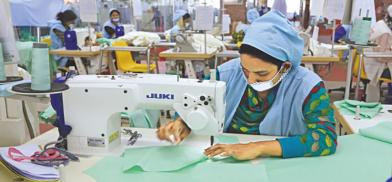Bangladesh's paradox of reopening its garment industry: Time to end dangerous working conditions
Considering the working environment and densely populated area combined with shabby living conditions of the workers, Dhaka and its neighboring districts of about 2.87 million people could be the next hotspot of the coronavirus outbreak, write Dr. Mohammad Rezaul Karim and Dr. Mohammad Tarikul Islam for South Asia Monitor

It is now evident that the COVID-19 situation in Bangladesh is better than the US or any European countries. Although 400-500 people on an average were found positive since last week, the number seems fewer than the forecast given by the experts and WHO. The comprehensive preparedness programme, including lockdown, movement restriction, intuitional and home quarantine system, isolation, and treatment has had a positive effect to control the pandemic. Moreover, an inclusive plan for the most vulnerable groups has stopped massive spread. The main reasons behind this relatively low infection was, apart from the restriction of movement, effective implementation of government strategies and relentless effort of public employees, particularly at the local level.
However, the movement of garment workers because of public holiday announcement increased the rate of infection. The sudden irrational decision of the owners forced the workers to move from villages to Dhaka, Gazipur, and Narayangonj where most garment factories are located. After questions were raised by civil society, the decision was withdrawn. After 10 hours and a hectic, troublesome journey, workers were forced to go back home. Movement of this huge population, which bore untold miseries as they trekked long distances, led to the faster spread of coronavirus that was till that time was relatively controlled.
A similar thing happened when the garment industries were instructed to open from 26 April. It was reportedly found that workers were called to join work without the issuance of a formal notification. The repetition of the same mistake increased the risk of frequent movement of a large group of people spreading coronavirus. It is reported that at least 126 people, who either moved from Dhaka and Narayanganj or came in close contact with residents of these two districts, have died. Gazipur, where many garment factories are located, is also identified as a hotspot. Around 60 percent of COVID-19 cases in Bangladesh are from these three areas.
Bangladesh has started its gradual move towards a normal life. Authorities have allowed the extension of the opening time of local shops and public offices. Eighteen ministries have been instructed to start their offices. Earlier, government officials were mainly operating to implement strategies to combat the COVID-19 pandemic. The opening of businesses increases the movement of people in the public area and maintaining social distancing thus become critical. Frontline fighters, law enforcement personnel, local government officials and bankers have a higher infection record. Still, almost 60 districts are under lockdown with the limited restrictions If all businesses are allowed to run, with the danger of people not following any social distancing norms and other safety measures, combating COVID-19 will get difficult, and chances are it will stay longer in Bangladesh. Considering the working environment and densely populated area combined with shabby living conditions of the workers, this area in Bangladesh, particularly Dhaka and its neighboring districts, of about 2.87 million people could be the next hotspot of coronavirus outbreak.
Considering the situation and effects of the virus, reopening of garment factories seems to be totally erroneous. However, reopening is also the demand of time. Factory owners have valid arguments. The government and garment workers – around four million - themselves are in favour of reopening factories. This labor-intensive sector not only provides employment opportunity for low-educated and unskilled or semiskilled workers but also contributes a lot to the national economy ($20.21 billion in 2018-2019). This sector is the main driving force for Bangladesh’s economic growth. It is the second-largest producer in the world with a big market in European countries and the US. China, Vietnam, Cambodia, and India are the key competitors. The first three countries have opened their garment industries as they have somehow managed to address the pandemic.
If Bangladesh does not allow the reopening of this crucial industry, the market may be captured by another competitor country. At this stage, cancellation of orders may be revived if industries can make it now. The industry has already faced a loss of $ 3 billion order cancellation in just one month. If the industry is opened, then the factory owners can minimize the loss as well. Reopening factories can foster economic growth and ease the lives of four million workers and their about 20 million family members. In fact, stopping economic activities will risk the lives of more than 20 million people because of impending starvation.
The paradox of reopening industries, particularly readymade garments, lies with the threats of joblessness, debts, mental ailments, depression, miserable living condition, malnutrition, poor schooling or no-schooling of children, non-availability of a healthcare facility, disruption of family life and moreover, the question of life and livelihood itself. Some factories have already started firing workers and layoffs are becoming common. This poses a major dilemma for Bangladesh - to open or close the garment industry.
The government intervention is important here, as it has already announced a Taka 5000 crore-stimulus package to cushion the crisis, particularly to pay the salary to the workers. The onus is now on factory management. They should make a comprehensive plan and redesign the working environment of the garment workers. Strong monitoring by the government will ensure that healthy work ethics combined with proper social distancing procedures and other safety measures are being followed. The garment industry can no longer afford to have dangerous working conditions; otherwise, the costs will be much more.
(Dr. Karim is Deputy Director, Bangladesh Public Administration Training Centre, Savar, Bangladesh. Dr. Islam is Associate Professor, Department of Government and Politics, University of Jahangirnagar, Savar, Bangladesh. The views expressed are personal. They can be contacted at reza@bpatc.org.bd and t.islam@juniv.edu respectively)








Post a Comment